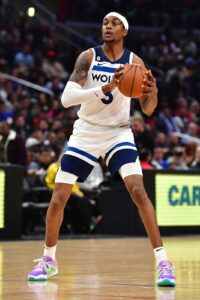The Timberwolves are setting a higher bar for their success as they enter their 35th season in the league, with team president Tim Connelly expressing his desire to win a playoff series in front of reporters at media day earlier this month, Jon Krawczynski of The Athletic writes.
After pushing in all their chips for Rudy Gobert last season, the Wolves faced several bumps in the road, including an injury to Karl-Anthony Towns, struggles by their stars to adapt, and not being able to close out teams with losing records. Still, the Wolves ran it back and are looking to improve on a 42-40 season.
“We like what we have. We’re bringing back pretty much the entire rotation. And we love our coaching staff,” Connelly said. “We love our core pieces and, fingers crossed, that the optimism is well placed.”
The Wolves committed to their core, signing Anthony Edwards, Naz Reid and Jaden McDaniels to contract extensions and returning the top six players from their playoff rotation. As Krawczynski writes, there’s pressure for the Wolves to win now with a suddenly expensive and aging roster. Gobert and Towns will make $93MM next season, Edwards’ salary jumps from $13.5MM to, at minimum, $35.5MM, among other spikes in salary and Mike Conley‘s impending free agency.
“There’s been a very loud mandate and risen bar about how we handle ourselves,” Connelly said. “It’s 82 games. There’s no BCS. We can’t take nights off. There were way too many nights last year when we just didn’t show up. But then against the elite teams, we showed what we’re capable of.”
We have more from the Timberwolves:
- Following the contract extensions the team completed this offseason, Chris Hine of the Star Tribune took a deeper look into Minnesota’s finances. As Hine explains, Edwards’ success will play a major role in the Timberwolves’ spending power looking forward because he can make up to $42.6MM if he makes an All-NBA team this season. Both Krawczynski and Hine note the Wolves are trending toward the second tax apron and that’s why there’s some speculation that the club might try and part with one of its large salaries by splitting it into multiple more palatable contracts, though that’s an issue for further down the road.
- Everything the Wolves have said and done indicates they view Edwards as their No. 1 franchise piece, Hine writes in a separate piece. “Pretty much every decision we’re going to make moving forward is going to be with Ant paramount,” Connelly said in April. However, there’s still room for Towns to have a profound impact on this franchise’s future and this season will go a long way in determining the upside of the Towns and Edwards duo, Hine explains.
- McDaniels is being listed as doubtful for the Wolves’ Saturday game against the Heat, according to the team (Twitter link). He’s dealing with a left calf strain.
 2:53pm: McDaniels’ new deal will actually be worth $131MM, with another $5MM available via incentives that are currently considered unlikely,
2:53pm: McDaniels’ new deal will actually be worth $131MM, with another $5MM available via incentives that are currently considered unlikely,